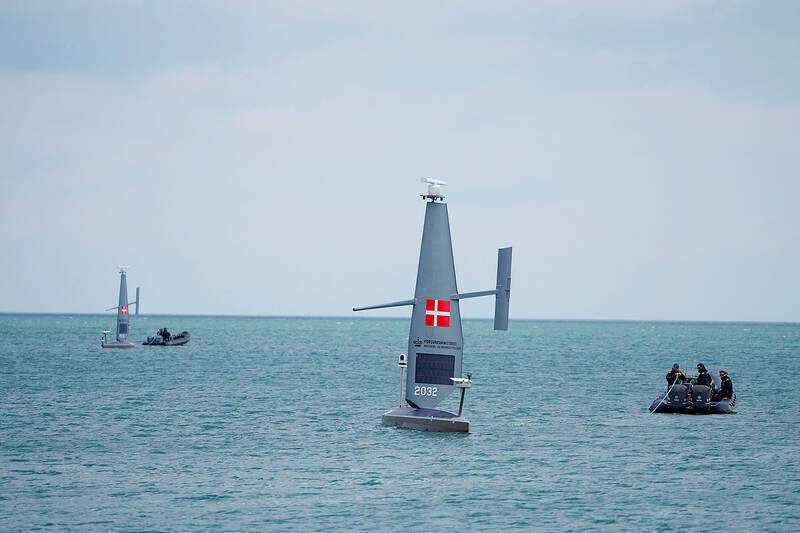From a distance they look almost like ordinary sailboats, their sails emblazoned with the red-and-white flag of Denmark. However, these 10m-long vessels carry no crew and are designed for surveillance.
Four uncrewed robotic sailboats, known as “Voyagers,” have been put into service by Denmark’s armed forces for a three-month operational trial.
Built by Alameda, California-based company Saildrone, the vessels are to patrol Danish and NATO waters in the Baltic and North Seas, where maritime tensions and suspected sabotage have escalated sharply since Russia’s full-scale invasion of Ukraine on Feb. 24, 2022.

Photo: Reuters
Two of the Voyagers launched on Monday from Koge Marina, about 40 km south of Copenhagen. Powered by wind and solar energy, the sea drones can operate autonomously for months at sea. Saildrone says the vessels carry advanced sensor suites — radar, infrared and optical cameras, sonar and acoustic monitoring.
Their launch comes after two others already joined a NATO patrol on June 6.
Saildrone founder and CEO Richard Jenkins compared the vessels to a “truck” that carries sensors, and uses machine learning and artificial intelligence to give a “full picture of what’s above and below the surface” to about 30km to 50km in the open ocean.
Maritime threats such as damage to undersea cables, illegal fishing, and the smuggling of people, weapons and drugs are going undetected simply because “no one’s observing it,” he said.
Saildrone is “going to places ... where we previously didn’t have eyes and ears,” he said.
The Danish Ministry of Defense says the trial is aimed at boosting surveillance capacity in undermonitored waters, especially around critical undersea infrastructure such as fiber-optic cables and power lines.
“The security situation in the Baltic is tense,” said Lieutenant General Kim Jorgensen, director of Danish National Armaments at the ministry. “They’re going to cruise Danish waters, and then later they’re going to join up with the two that are on [the] NATO exercise. And then they’ll move from area to area within the Danish waters.”
The trial comes as NATO confronts a wave of damage to maritime infrastructure — including the 2022 Nord Stream pipeline explosions and the rupture of at least 11 undersea cables since late 2023. The most recent incident, in January, severed a fiber-optic link between Latvia and Sweden’s Gotland island.
The trial also unfolds against a backdrop of trans-Atlantic friction — with US President Donald Trump’s administration threatening to seize Greenland, a semiautonomous territory belonging to Denmark, a NATO member. Trump has said he would not rule out military force to take Greenland.
Jenkins said that his company had already planned to open its operation in Denmark before Trump was re-elected.
He did not want to comment on the Greenland matter, saying the company is not political.
Some of the maritime disruptions have been blamed on Russia’s so-called shadow fleet — aging oil tankers operating under opaque ownership to avoid sanctions.
One such vessel, the Eagle S, was seized by Finnish police in December for allegedly damaging a power cable between Finland and Estonia with its anchor.
Western officials accuse Russia of being behind a string of hybrid war attacks on land and at sea.
Amid these concerns, NATO is moving to build a layered maritime surveillance system combining uncrewed surface vehicles like the Voyagers with conventional naval ships, satellites and seabed sensors.
“The challenge is that you basically need to be on the water all the time, and it’s humongously expensive,” said Peter Viggo Jakobsen of the Royal Danish Defense College. “It’s simply too expensive for us to have a warship trailing every single Russian ship, be it a warship or a civilian freighter of some kind.”
“We’re trying to put together a layered system that will enable us to keep constant monitoring of potential threats, but at a much cheaper level than before,” he added.

The Burmese junta has said that detained former leader Aung San Suu Kyi is “in good health,” a day after her son said he has received little information about the 80-year-old’s condition and fears she could die without him knowing. In an interview in Tokyo earlier this week, Kim Aris said he had not heard from his mother in years and believes she is being held incommunicado in the capital, Naypyidaw. Aung San Suu Kyi, a Nobel Peace Prize laureate, was detained after a 2021 military coup that ousted her elected civilian government and sparked a civil war. She is serving a

China yesterday held a low-key memorial ceremony for the 1937 Nanjing Massacre, with Chinese President Xi Jinping (習近平) not attending, despite a diplomatic crisis between Beijing and Tokyo over Taiwan. Beijing has raged at Tokyo since Japanese Prime Minister Sanae Takaichi last month said that a hypothetical Chinese attack on Taiwan could trigger a military response from Japan. China and Japan have long sparred over their painful history. China consistently reminds its people of the 1937 Nanjing Massacre, in which it says Japanese troops killed 300,000 people in what was then its capital. A post-World War II Allied tribunal put the death toll

‘NO AMNESTY’: Tens of thousands of people joined the rally against a bill that would slash the former president’s prison term; President Lula has said he would veto the bill Tens of thousands of Brazilians on Sunday demonstrated against a bill that advanced in Congress this week that would reduce the time former president Jair Bolsonaro spends behind bars following his sentence of more than 27 years for attempting a coup. Protests took place in the capital, Brasilia, and in other major cities across the nation, including Sao Paulo, Florianopolis, Salvador and Recife. On Copacabana’s boardwalk in Rio de Janeiro, crowds composed of left-wing voters chanted “No amnesty” and “Out with Hugo Motta,” a reference to the speaker of the lower house, which approved the bill on Wednesday last week. It is

FALLEN: The nine soldiers who were killed while carrying out combat and engineering tasks in Russia were given the title of Hero of the Democratic People’s Republic of Korea North Korean leader Kim Jong-un attended a welcoming ceremony for an army engineering unit that had returned home after carrying out duties in Russia, North Korean state media KCNA reported on Saturday. In a speech carried by KCNA, Kim praised officers and soldiers of the 528th Regiment of Engineers of the Korean People’s Army (KPA) for “heroic” conduct and “mass heroism” in fulfilling orders issued by the ruling Workers’ Party of Korea during a 120-day overseas deployment. Video footage released by North Korea showed uniformed soldiers disembarking from an aircraft, Kim hugging a soldier seated in a wheelchair, and soldiers and officials